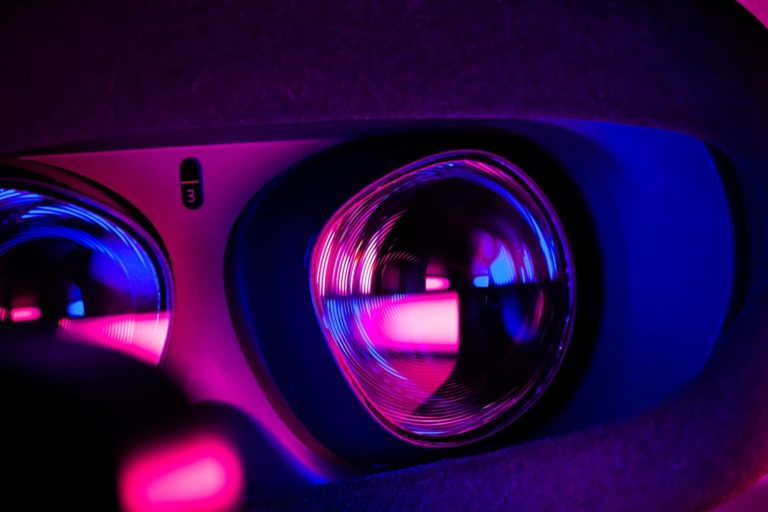
Virtual reality has come a long way since the first head-mounted displays (HMDs) were invented in the 1960s. Today, we have advanced technologies such as Meta Quest 2, PSVR 2, and enterprise-grade high-resolution headsets from the likes of Varjo. The next step in this evolution, though it will be a long road, is the creation of a Metaverse – a fully immersive virtual world where people can interact with each other and objects in a shared space.
In this three-part series, we’ll explore the evolution of virtual reality and how it has paved the way for the Metaverse… starting at the beginning.
The Early Days of Virtual Reality
VR’s inception is often credited to Ivan Sutherland’s 1968 HMD system. Known as the Sword of Damocles, it required users to be suspended from the ceiling and could only display simple wireframe graphics. The history of VR has seen several advances since then, with the introduction of more sophisticated VR systems in the 1980s and 1990s, and high-end VR systems in the early 2000s. Despite these limitations, early HMDs set the foundation for future advancements in VR technology.
Early VR experiments and applications date back to the 1960s when researchers and scientists first began exploring the potential of creating a simulated environment using computer technology. One of the earliest applications of VR was in the field of flight simulation. In the 1960s and 1970s, the military and aviation industries used VR technology to train pilots and test new aircraft designs. These simulators were often large, expensive systems that used HMDs and other sensory input devices to create a realistic flight experience. In the 1980s and 1990s, VR technology began to be used in other industries, such as automotive design, architecture, and healthcare.
The entertainment industry has also played a significant role in the development and popularization of VR technology. The first commercial VR system, the Virtuality, was released in 1991, followed by other systems such as the Sega VR, Nintendo Virtual Boy, and the VFX-1. These systems were popular among gamers and enthusiasts, despite having basic graphics and limited capabilities. Virtual reality arcades also became popular, offering customers the opportunity to play games and experience VR for themselves.
Science fiction has had a significant impact on the development and popularization of virtual reality technology. For instance, “The Veldt” by Ray Bradbury, published in 1950, depicts a futuristic virtual reality room where children can create and experience any environment they want. This concept helped popularize the idea of simulated reality and influenced the development of early VR experiments. The 1992 film “The Lawnmower Man” featured a character who becomes trapped in a virtual reality simulation, introducing the idea of immersive VR technology to a wider audience. More recently, the 2011 novel “Ready Player One” and its subsequent film adaptation in 2018 have also had a significant impact on the popularity and development of VR technology.
The Rise of Consumer VR
Virtual Reality (VR) technology has been a topic of fascination for decades. Initially, it was mostly used in the military, medical, and gaming industries. However, with the development of affordable hardware, VR technology is now available to consumers, and it is rapidly gaining popularity.
One of the most significant factors contributing to the rise of consumer VR is the development of affordable VR hardware. In the past, VR technology was expensive, and only a few people could afford it. However, with the advent of affordable VR headsets, such as the Meta Quest 2, VR technology is becoming accessible to more people. This has opened up new opportunities for various industries, including entertainment, education, healthcare, and more.
One key inflection point towards that end was the Oculus Rift. Released in 2016 by the Meta-owned Oculus (then Facebook), the device has several features that make it stand out from other VR headsets. For instance, it had a high-resolution display, which provided a more immersive experience than headsets seen so far, including the device’s own predecessors, the Oculus DK1 and DK2. Additionally, it had six degrees of freedom (6DOF) tracking, which allowed users to move their heads in all directions, as well as a built-in audio system so that immersive sound could accompany immersive visuals.
All the above unlocked VR experiences and appeal to broader audiences in gaming, education, and healthcare. The device revolutionized how users experience games. In education, it enabled virtual field trips and science simulations. In healthcare, it was used to train medical professionals and to create immersive therapy experiences for patients.
VR’s Evolutionary Path
Parallel to Oculus Rift, the 2016 HTC Vive similarly unlocked a larger market for VR, utilizing a more advanced (albeit more cumbersome) room-scale tracking technology. This enabled experiences that more effectively utilized 6 degrees of freedom. Meanwhile, PlayStation VR was also released in 2016. Piggybacking on an installed base of 100 million PlayStation consoles, this lowered the all-in price of VR for consumers that already owned the console. It also made VR more accessible and simple than PC-based headsets like Rift and VIVE.
Eventually, Oculus Rift gave way to Oculus Quest 1, which was then superseded by Meta Quest 2. And Meta Quest Pro hovers in higher-end VR territory, including passthrough AR capabilities HTC has meanwhile broadened its VIVE line into the Cosmos, Focus, enterprise-geared headsets, as well as simpler personal entertainment devices (PEDs) like VIVE flow. And the recent VIVE Elite is HTC’s answer to the Quest Pro. Lastly, PSVR has given way to PSVR2 (though they will coexist for a while), which taps into the more advanced graphical processing of the PlayStation 5.
And that brings us to the present, at least as far as a representative sample of today’s VR hardware. We’ll pause there and return next week in Part II of the series with the next stage of VR’s evolution in its steps toward enabling the eventual manifestation of a metaverse.

Kyr Poskonoff is the host of the LikeXR.tech podcast, Co-founder at LikeXR.com, AWE Speaker, and author of the book “Metaversions”

